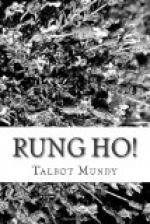The stables—rather the patch-and-hole-covered desolation that once had been stables—were altogether too snake-defiled and smelly to be worth repairing; the string of horses was quartered cleanly and snugly under tents, and Mahommed Gunga went to enormous trouble in arranging a ring of watch-fires at even distances.
“Are there thieves here, then?” asked Cunningham, and the Rajput nodded but said nothing. He seemed satisfied, though, that the man he had brought safely thus far at so much trouble would be well enough housed in the creaky wreck of the bungalow, and he took no precautions of any kind as to guarding its approaches.
Cunningham watched the preparations for his supper with ill-concealed disgust—saw the customary chase of a rubber-muscled chicken, heard its death gurgles, saw the guts removed, to make sure that the kansamah did not cook it with that part of its anatomy intact, as he surely would do unless watched—and then strolled ahead a little way along the road.
The fakir was squatting in the distance, on a big white stone, and in the quiet of the gloaming Cunningham could hear his coarse, lewd voice tossing crumbs of abuse and mockery to the seven or eight villagers who squatted near him—half-amused, half-frightened, and altogether credulous.
Even as he drew nearer Cunningham could not understand a word of what the fakir said, but the pantomime was obvious. His was the voice and the manner of the professional beggar who has no more need to whine but still would ingratiate. It was the bullying, brazen swagger and the voice that traffics in filth and impudence instead of wit; and, in payment for his evening bellyful he was pouring out abuse of Cunningham that grew viler and yet viler as Cunningham came nearer and the fakir realized that his subject could not understand a word of it.
The villagers looked leery and eyed Cunningham sideways at each fresh sally. The fakir grew bolder, until one of his listeners smothered an open laugh in both hands and rolled over sideways. Cunningham came closer yet, half-enamoured of the weird scene, half-curious to discover what the stone could be on which the fakir sat.
The fakir grew nervous. Perhaps, after all, this was one of those hatefully clever sahibs who know enough to pretend they do not know! The abuse and vile innuendo changed to more obsequious, less obviously filthy references to other things than Cunningham’s religion, likes, and pedigree, and the little crowd of men who had tacitly encouraged him before got ready now to stand at a distance and take sides against him should the white man turn out to have understood.
But Cunningham happened to catch sight of a cloud of paroquets that swept in a screaming ellipse for a better branch to nest in and added the one touch of gorgeous color needed to make the whole scene utterly unearthly and unlike anything he had ever dreamed of, or had seen in pictures, or had had described to him. He stood at gaze—forgetful of the stone that had attracted him and of the fakir—spellbound by the wonder-blend of hues branch-backed, and framed in gloom as the birds’ scream was framed in silence.




